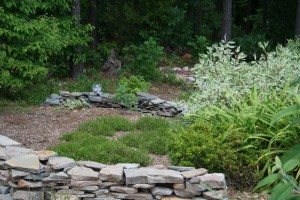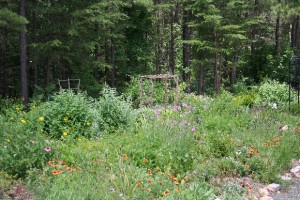 |
| A serene, green corner of the garden. |
With all the talk about color palettes and color wheels and coordinating color in the garden, it’s easy to forget that green counts as a color, too. Many garden design books talk about green as a ‘neutral.’ I think of green in the garden the way I think of my favorite pair of black pants. It goes with everything. With the thick backdrop of loblolly pine trees behind the garden, dark green is the backdrop here to the flowers. And of course all the flowers have green leaves, except the dead plants but I don’t count those.
Yet when you have just green shades in the garden, it can be very soothing. There’s one corner of the flower garden that now rests in shades of greens and grays. In early spring, the mounds of phlox growing low on the ground are covered with bright pink blossoms, but by June they are resting and refreshing themselves, growing and spreading out.
The variegated green leaves you see in the right side are from my red twig dogwood. It does not have flowers, but the leaves offer beautiful color and interest. They are a light green color with plenty of white on them. The stems and trunk of the red twig dogwood are red – a bright cardinal red. During the winter, when the leaves are gone from the shrub and there’s not much to look at in the garden, it really does provide a beautiful contrast, especially in the snow.
Other greens adding interest include the spiky foliage from the day lilies. Many of the day lilies are starting to bloom, but I have some thick clumps of what is euphemistically called ditch lilies – the orange tiger lilies that grow wild by the roadside of America – and these have dark green, sword-like foliage which is quite attractive.
Another big swatch of green in the garden is the yarrow. Achillea “Fire King” has spread throughout the sunny perennial garden. Soon, the clusters or florets will begin blooming, adding a sort of red-purple mistlike haze over the great swaths of lace-like green leaves. Behind them are the Rudbeckia, the Black Eyed Susan, and various daisies. While the daisies have begun blooming with cheerful yellow flowers, the daisy and Rudbeckia foliage adds more green.
 |
| Flower garden, June 2012 |
The green area offers a peaceful, restful place during the hot summer days. I can look out my office windows at this scene, and although I am looking at it from above and a different perspective than in the photograph, it does offer a serene place for contemplation and retreat when I need a brief respite from work.





what would a garden be without green…..